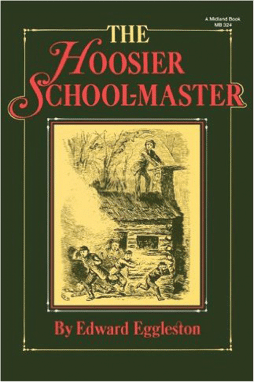
Hoosier Hall of Fame: The Indiana Authors
This story is part of Indianapolis Monthly’s 2016 Indiana Bicentennial coverage, which includes our list of the 200 Hoosier Hall of Fame picks, designated throughout in bold. For more on this celebration of the state’s first two centuries, click here.
At the turn of the last century, Indiana accounted for more bestselling authors than any state besides New York, and contemporary writers from Kurt Vonnegut to John Green helped maintain our literary cred. But if you skipped these classic Hoosier reads in high school, consider this your tl;dr— “too long;didn’t read” in social-media shorthand—synopsis.
EDWARD EGGLESTON
The Vevay native relied on his brother’s experiences teaching in Madison to inform his most popular work.
THE CLASSIC The Hoosier School-Master (1871)
TL;DR? Ralph Hartsook takes over the rural Flat Creek, Indiana, schoolhouse, winning over the provincial townspeople—whom Eggleston gives depth and respect (even if the backwoods dialect he employs muddies the dialogue).
LEW WALLACE
The Brookville-born Union general and artist wrote the bestselling novel of the 19th century.
THE CLASSIC Ben-Hur: A Tale of the Christ (1880)
TL;DR? The life of a Jewish prince turned slave turned merchant intertwines with Christ’s in an epic tale of betrayal, love, redemption—and a chariot race. A new movie version starring Jack Huston will hit the big screen this August.
JAMES WHITCOMB RILEY
Known as “The Hoosier Poet” and “The Children’s Poet,” the Greenfield native sold millions of books.
THE CLASSIC Rhymes of Childhood (1890)
TL;DR? If we’re being honest, Riley’s homespun vernacular in beloved poems such as “The Raggedy Man” and “Little Orphant Annie”—both collected here—and subject matter like “The Happy Little Cripple” can make the modern reader cringe a bit.
THEODORE DREISER
The Terre Haute native is still respected for his “naturalistic” (read: unfiltered and sometimes vulgar) dialogue and storytelling.
THE CLASSIC Sister Carrie (1900)
TL;DR? Columbia City girl Carrie Meeber runs away to make it in Chicago, lives with a sugar daddy, ditches him for a married man, and becomes a rich, famous actress in NYC while her lover declines and commits suicide. A pessimistic critique of the American Dream. Sounds juicy, reads dry.
GENE STRATTON-PORTER
An Indiana swamp inspired the author, especially for this novel, which sold millions.
THE CLASSIC A Girl of the Limberlost (1909)
TL;DR? Elnora Comstock’s complicated relationship with her cold mother develops while the girl collects moths from the swamp to fund her schooling. A love story with an outsider ensues, but the vivid descriptions of Elnora’s lunchbox are the best parts.
BOOTH TARKINGTON
The bestselling Indy novelist won two Pulitzer Prizes while keenly observing Midwest upper and middle classes.
THE CLASSIC The Magnificent Ambersons (1918)
TL;DR? Spoiled “Midland” (read: Indianapolis) aristocrat George falls to ruin after dashing his mother’s hopes for love and ignoring the city’s progress. Biting look at the ephemeral nature of social status—and the importance of not being a stubborn jerk.
KURT VONNEGUT
His Indy family’s fall during the Depression and his time as a World War II POW shaped the humanist’s literary tone and topics.
THE CLASSIC Slaughterhouse-Five (1969)
TL;DR? Life and death, fantasy and reality are examined in the tragicomic tale of Billy Pilgrim, a WWII prisoner during the firebombing of Dresden. Instead of free will, Vonnegut posits, everything is predestined—hence the book’s famous motto: “So it goes.”
MARI EVANS
The poetry, children’s lit, and plays of this Indy resident are celebrated for their insight into the African-American experience.
THE CLASSIC I Am a Black Woman (1970)
TL;DR? Evans elegantly fuses the civil rights and feminist movements in this poetry collection, which catapulted her into the national conversation. The beauty, power, and pain she evokes in pieces such as “Who Can Be Born Black” are still poignant today.
JAMES ALEXANDER THOM
This longtime journalist and Gosport native’s intensely researched historical novels have sold millions of copies.
THE CLASSIC Follow the River (1981)
TL;DR? Thom lived off the land to lend vivid detail to this tale of a Virginia mother’s kidnapping by the Shawnee. She eventually escapes via a 1,000-mile walk to her village. A riveting ode to the courage of one pioneer woman.
JOHN GREEN
“Vlogstar” Green’s young-adult fiction fans are legion.
THE CLASSIC The Fault in Our Stars (2012)
TL; DR? Captivating high-schooler Hazel Lancaster offers an unfiltered look at life with cancer, falls in love with a fellow cancer patient, gets disappointed by her favorite author, and deals with her boyfriend’s death. Gives you “all the feels,” yes, but the couple’s wry outlook and banter ensure laughter between the sobs.
This story originally ran in the January 2016 issue.














